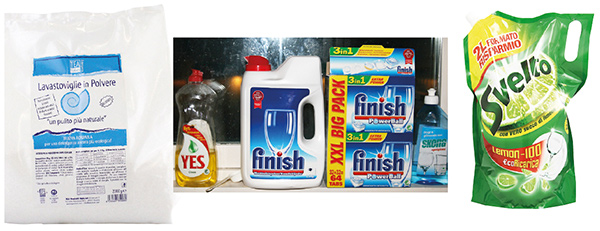Chemical products for the home: the packaging
Performance of domestic detergent products and corresponding packaging use.
Barbara Iascone

According to the classification used by Federchimica Assocasa, the sector of products for cleaning, maintenance and hygiene of spaces includes detergents, laundry soaps, auxiliary washing products, disinfectants including air sanitizers, waxes, auto care products, air fresheners and cleaning products generally.
The association’s annual report, released in February 2017, shows an overall drop in sales in terms of value (-2.7%), largely attributed to disinfectants, which saw a -13.7% drop.
Detergents went down by 1.9%, with -2% for laundry detergents and -1.3% for dish soaps and dishwasher detergents.
Nonetheless, in laundry detergents, liquid products for machine washing showed some growth (+0.6%), while powder detergents for machine washing saw decline (-7.4%), along with liquid hand wash products (-14%) and those for delicate articles (-5.7%).
In dishwashing products, those for machine washing saw growth (+2.2%), while those for handwashing shrank (-4.2%).
A look at other sectors shows a 1.2% drop in auxiliary products (softeners, etc.) and a 2.5% drop in maintenance products.
This picture changes radically if one looks at the numbers in quantitative terms rather than in terms of value. According to Istat data, the detergents sector’s total 2016 production saw 2.4% growth, reaching a total of 2,282,000 t (+3% greater than that of 2015).
This divergence in performance depending on the metric used is basically attributable to the Italian consumer’s propensity for saving,
a trend that has been observed
during the last several years.
The detergents industry is moreover making great efforts to, on one hand, satisfy the needs and demands of families, while on the other hand offering innovative, high performance products. As a matter of fact, while today’s consumers aim to save, they also seek effective products that are at the same time ecological and respect the environment. This trend not only influences the products themselves but also the packaging choices in a market that is mature yet still vital in terms of product innovation.
Distribution channels
As for sales channels, still according to Assocasa’s analysis, the only distribution channels seeing any growth are specialist stores (drug specialists) with 2.1% and offering a wide assortment of quantities and quality ranges, as well as opportunities for saving. Discount stores have largely remained stable with +0.1%, and hyper- and supermarkets have seen decline. Packaging types
The detergents sector continues to be dominated by plastic packaging, both rigid and flexible: the only shifts in market share distribution have thus been among different types of plastic packaging.
The choice of packaging material, as in the chemical sector as a whole, is largely a function of the chemical and physical properties of the product to be packaged, but also depends on the communication needs at play for the various commercial brands and product innovations to set themselves apart. The database of Istituto Italiano Imballaggio shows the following packaging mix:
In 2016, plastic packaging made up 93.5% of packaging for household cleaning and maintenance products. This percentage has been constant for the past several years.
More specifically, we find:
- plastic bottles, which in 2016 made up 67.8% (-0.7% compared to 2015);
- containers made from flexible polylaminate for converting, which has been growing year after year and which in 2016 reached 22.5% of the total;
- refills for the bottles of detergent, made using biodegradable plastic material (and thus joining the ranks of plastic packaging in this sector), showing constant growth and reaching 1.2% of the total packaging mix in 2016.
The last type of packaging on the list above, in particular, is used for concentrate products that when added to hot water in a plastic bottle are diluted, releasing the right amount to reconstitute the detergent or the original detergent. Another component of plastic packaging are the wrapping films used for bar soaps (1%), as well as tubes (1%).
The remaining 6.5% of packaging for this sector is made up of:
- paperboard boxes used mainly for powder and tab products for dishwashing machines, which in 2016 remained stable at 4%;
- metal spray cans (now exclusively in steel to the detriment of aluminium), at 1.5%;
- rigid polylaminate containers at 1%;
- the remaining 0.5% is made up of automatic dispensation of loose products, a phenomenon that has not gained as much traction in Italy as in other countries, and which has declined over the years.
In addition to primary packaging, there is secondary transport packaging (corrugated cardboard boxes, heatshrink films and pallets).

Detergents during the early months of 2017
Istat data relating to the first 5 months of 2017 confirms that the detergents sector is off to a good start, with production 1.4% higher than during the same period in 2016. During that time, foreign trade has been characterized by imports down by 2.3% and exports up by 4.5%.
Apparent consumption should decrease by 1,2%. Istituto Italiano Imballaggio projects that the 2016 trends in the sector’s packaging mix should continue in the current year, with flexible and biodegradable plastic containers on the rise, reaching 22.8% and 1.4%, respectively. These increases will be to the detriment of ordinary plastic bottles.
100% rPET flacons by Henkel
A clear example of sustainable innovation in detergent packaging, the solution enables the saving of around 413 tons of virgin plastic a year, reusing around 550 tons of plastic waste.
Awarded in 2016 under the Conai Call for Prevention, the flacons were in particular rated under three indicators: (Global Warming Potential), or that is the carbon footprint; GER (Gross Energy Requirement) or that is the total consumption of energy during the entire lifecycle of the flacon; H2O, entailing the processing water used to achieve the creation of this bottle.
Barbara Iascone
Istituto Italiano Imballaggio

















